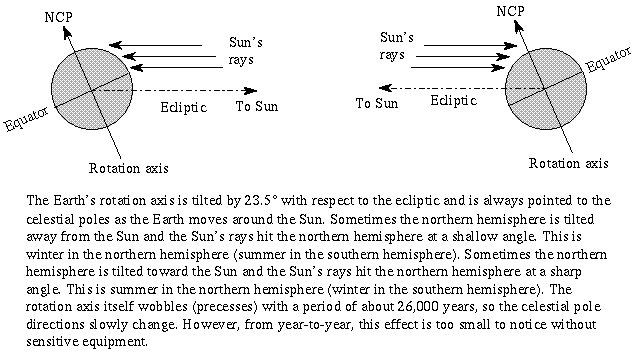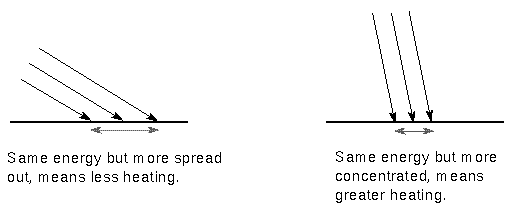
Video lecture for this chapter
The seasonal temperature depends on the amount of heat received from the Sun in a given time. To hold the temperature constant, there must be a balance between the amount of heat gained and the amount radiated to space. If more heat is received than is lost, your location gets warmer; if more heat is lost than is gained, your location gets cooler. What causes the amount of energy reaching a given location during the day to change throughout the year?
Two popular theories are often stated to explain the temperature differences of the seasons: 1) the different distances the Earth is from the Sun in its elliptical orbit (at perihelion the Earth is 147.1 million kilometers from the Sun and at aphelion the Earth is 152.1 million kilometers from the Sun); and 2) the tilt of the Earth's axis with respect to its orbital plane. If the first theory were true, then both the north and south hemispheres should experience the same seasons at the same time. They do not. Using the scientific method discussed in chapters 1 and 2, you can reject the distance theory.
A popular variation of the distance theory says that the part of the Earth tilted toward the Sun should be hotter than the part tilted away from the Sun because of the differences in distances. If you continue along with this line of reasoning, then you conclude that the night side of the Earth is colder than the daylight side because the night side is farther away from the Sun. This ignores the more straightforward reason that the night side is directed opposite the Sun, so the Sun's energy does not directly reach it. But let's examine the tilt-distance model a little more. The 23.5° tilt of the Earth means that the north pole is about 5080 kilometers closer than the south pole toward the end of June. This is much, much smaller than the 152 million kilometer distance between the Sun and the Earth's center at that time. The amount of energy received decreases with the square of the distance.
If you calculate (152,000,000 + 5080)2/(152,000,000 - 5080)2, you will find that the north pole would get slightly over 1/100th of one percent more energy than the south pole. This is much too small a difference to explain the large temperature differences! Even if you compare one side of the Earth with the opposite side, so you use the Earth's diameter in place of the 5080 kilometers in the calculation above, you get 3/100th of one percent difference in energy received. Clearly, distance is not the reason for the large temperature differences. Notice that I used the aphelion value for the distance between the Earth and Sun. That is because the Earth is near aphelion during the northern hemisphere's summer! This is known by measuring the apparent size of the Sun. You can safely assume that the Sun's actual size does not vary with a period that depends on the orbital period of a planet thousands of times smaller than it, or that it would choose the Earth's orbital period as its pulsation cycle.
Earth reaches perihelion in the first week of January (during the north hemisphere's winter!) and aphelion in the first week of July (during the north hemisphere's summer!). The distance theory predicts the opposite seasons from what's observed in the north hemisphere. Precise dates and times for the perihelion and aphelion events can be found at the US Naval Observatory's Applications Department's Earth's Seasons page (link will appear in a new window; make the appropriate time adjustment for your time zone.)
Even though the distance model (in any variation) is incorrect, it is still a ``good'' scientific theory in that it makes testable predictions of how the temperature should change throughout the year and by how much. However, what annoys scientists, particularly astronomy professors, is ignoring those predictions and the big conflicts between predictions and what is observed. Let's take a look at a model that correctly predicts what is observed.

The tilt theory correctly explains the seasons but the reason is a little more subtle than the distance theory's explanation. Because the Earth's rotation axis is tilted, the north hemisphere will be pointed toward the Sun and will experience summer while the south hemisphere will be pointed away from the Sun and will experience winter. During the summer the sunlight strikes the ground more directly (closer to perpendicular), concentrating the Sun's energy. This concentrated energy is able to heat the surface more quickly than during the winter time when the Sun's rays hit the ground at more glancing angles, spreading out the energy.

Also, during the summer the Sun is above the horizon for a longer time so its energy has more time to heat things up than during the winter. Like baking something in the oven, the land and water do not heat up instantaneously, so our hottest days are usually after the summer solstice. That is also why the hottest part of the day is usually in the afternoon. Similarly, the coldest days are winter are usually after the winter solstice.

The Seasons module of the University of Nebraska-Lincoln's Astronomy Education program enables you to understand these concepts by manipulating such things as the position of the Earth in its orbit and your position on the Earth (link will appear in a new window---choose the third part of the module) and use their Seasons and Ecliptic Simulator in the Native Apps package (the Flash simulators no longer work with today's browsers).. You can switch between an earth-centered view showing the Earth at the center of the celestial sphere with the Sun traveling along the ecliptic and a Sun-centered view showing the Earth moving around the Sun. Both views show how the amount of daylight and the angle of sunlight upon the ground change with the passing days and the location on the Earth.
The rotational axes of most of the other planets of the solar system are also tilted with respect to their orbital planes so they undergo seasonal changes in their temperatures too. The planets Mercury, Jupiter, and Venus have very small tilts (3° or less) so the varying distance they are from the Sun may play more of a role in any seasonal temperature variations. However, of these three, only Mercury has significant differences between perihelion and aphelion. Its extremely thin atmosphere is not able to retain any of the Sun's energy. Jupiter's and Venus' orbits are very nearly circular and their atmospheres are very thick, so their temperature variations are near zero.
Mars, Saturn, and Neptune have tilts that are similar to the Earth's, but Saturn and Neptune have near zero temperature variation because of their very thick atmospheres and nearly circular orbits. Mars has large temperature changes because of its very thin atmosphere and its more eccentric orbit places its southern hemisphere closest to the Sun during its summer and farthest from the Sun during its winter. Mars' northern hemisphere has milder seasonal variation than its southern hemisphere because of this arrangement. Since planets move slowest in their orbits when they are furthest from the Sun, Mars' southern hemisphere has short, hot summers and long, cold winters.
Uranus' seasons should be the most unusual because it orbits the Sun on its side---its axis is tilted by 98 degrees! For half of the Uranian year, one hemisphere is in sunlight and the other is in the dark. For the other half of the Uranian year, the situation is reversed. The thick atmosphere of Uranus distributes the solar energy from one hemisphere to the other effectively, so the seasonal temperature changes are near zero. Pluto's axis is also tilted by a large amount (122.5 degrees), its orbit is the most elliptical of the planets, and it has an extremely thin atmosphere. But it is always so far from the Sun that it is perpetually in deep freeze (only 50 degrees above absolute zero!).
![]() Go back to previous section --
Go back to previous section --
![]() Go to next section
Go to next section
last updated: January 18, 2022